Inside Deep Undersea Rocks, Life Thrives Without the Sun
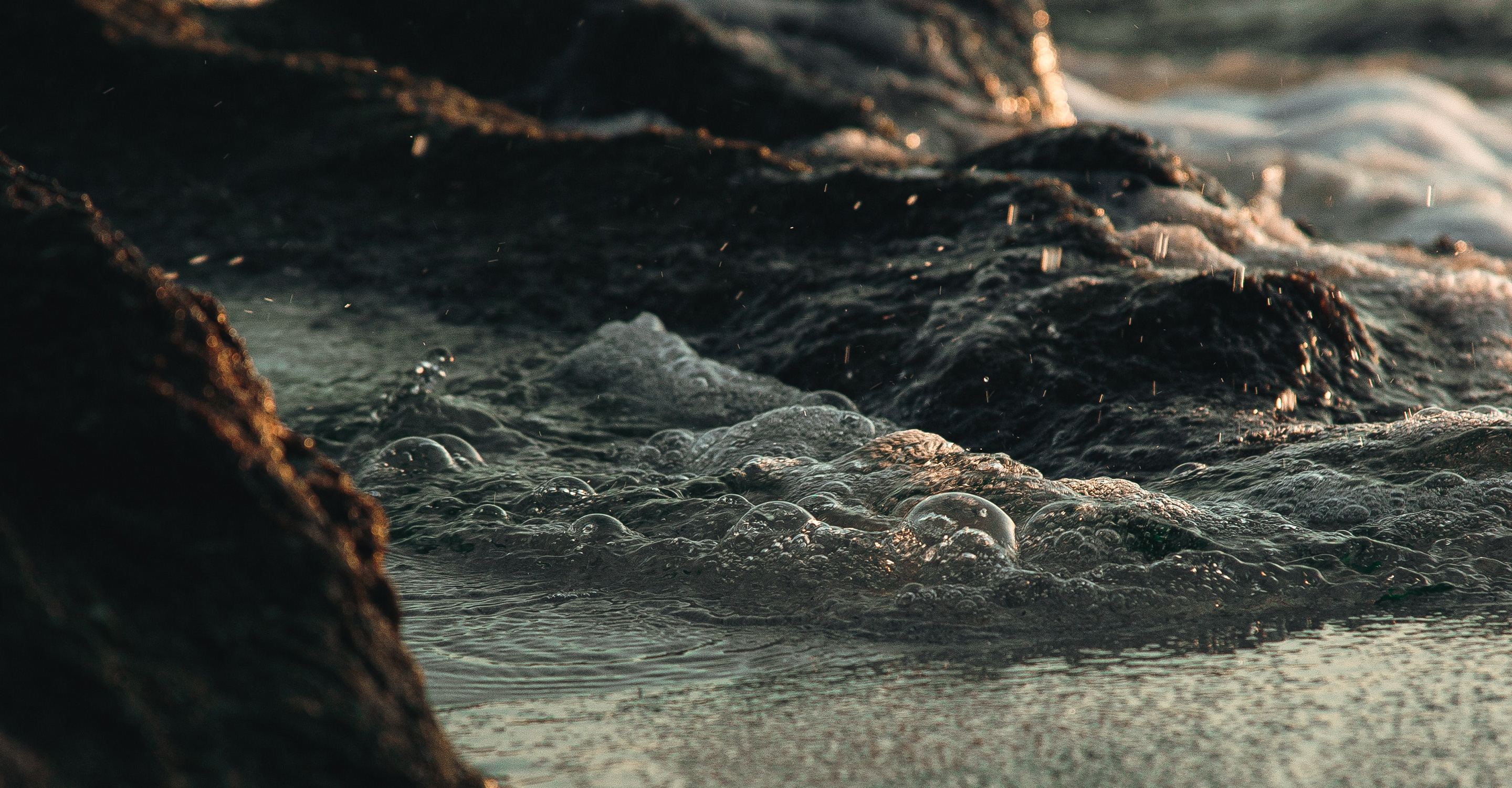
Life may have first emerged in pools of water swirling among rocks. As scientists continue to find microbes deeper and deeper beneath the ocean floor, they are beginning to suspect that the right combination of rocks and water might be enough to sustain life almost anywhere.
Introduction
Microbial life, almost unbelievably resilient, abides in boiling hot springs and bone-dry deserts, in pools of acid and polar ice, kilometers up into the sky and kilometers below the ocean floor. And while scientists are eager to uncover microbes in even less familiar territories beyond our solar system, it’s the last Earth-bound frontier on that list — the deep subsurface — where they’re now making exciting progress in their efforts to probe life’s extreme adaptability.
Lightless, barren of essential nutrients and crushed under inconceivable pressures, the deep subsurface seems unrelentingly inhospitable, yet it is shaping up to be one of Earth’s biggest habitats. Moreover, its strangeness is forcing scientists to reckon with biological systems that operate on completely different energy sources and time scales from those that we surface dwellers are accustomed to.
Scientists have spent decades studying how and where microbes persist and even thrive beneath the oceans, far removed from the sun. Most of that work has focused on marine sediments, the tightly packed mud and detritus that in places extends for kilometers beneath the water. But there’s also the volcanic rock below that, the crust itself. The life in those rocks is much more difficult to access and analyze, and samples are scarce.
“We do not have a map of the deep subsurface microbial landscape right now,” said Karen Lloyd, a microbiologist at the University of Tennessee, Knoxville. As a result, she noted, researchers studying its diverse range of environments can’t even make simple generalizations equivalent to “forests have trees and fish swim in the oceans.”
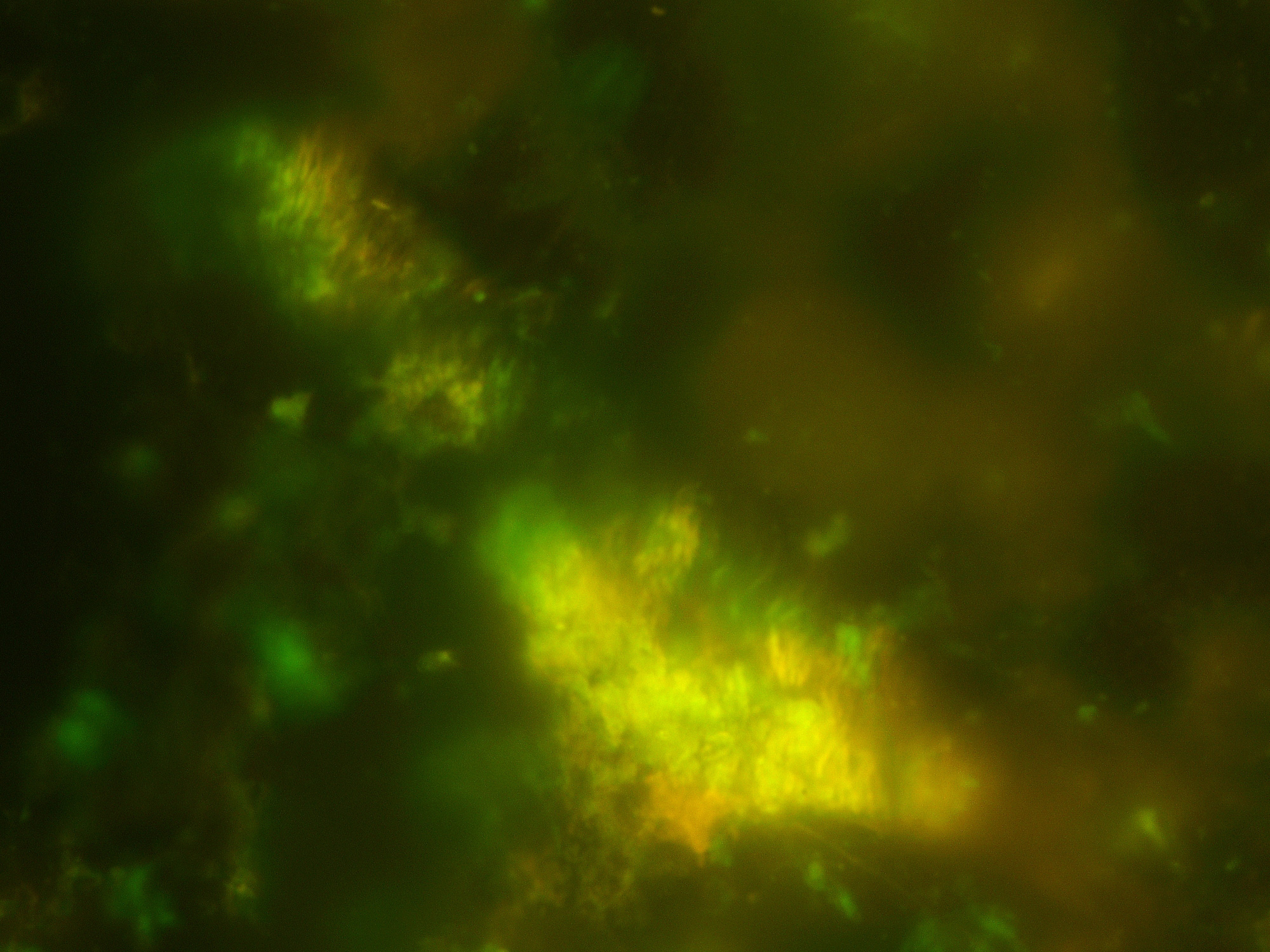
Fluorescence microscopy shows the remarkable density of bacteria growing inside basaltic rocks sampled from below the seafloor. The cells are stained green; yellow shows where the cells are inside aggregates of clay minerals.
Yohey Suzuki, CC BY 4.0
But a handful of new discoveries has finally opened a window onto that landscape and the microbes that inhabit it. It has also offered a glimpse into the very origin and evolution of life, both on this planet and possibly elsewhere in the universe.
Life Without the Sun
Earth’s crust has largely been the purview of geologists. The first indication that it might also be of interest to microbiologists came in 1926, when researchers reported the presence of bacteria in the deep oil wells of Illinois. Such findings, however, wouldn’t be taken seriously for decades: Contamination in the samples seemed far more likely than the possibility that anything could live so disconnected from the sun-driven photosynthesis that supports life everywhere else on the planet. (It didn’t help that in the 1950s, a pair of microbiologists performed a series of experiments that led them to pin the bottom of the biosphere to sediments just a few meters below the seafloor.)
In 1977, that all began to change. Scientists boarded a submarine to explore a spreading ocean ridge between two tectonic plates near the Galápagos Islands, and discovered the first hydrothermal vents. There, the Earth belched out billows of black smoke, as scalding-hot, mineral-rich fluids spewed from cracks in the rock and mixed with the extremely cold seawater. Around those vents, an entire ecosystem flourished, including tube worms, giant clams and eyeless shrimp — and, it turned out, lots and lots of microbes that sustained them. “There, in these dark, deep parts of the ocean where they didn’t expect to find life, certainly they did,” said Barbara Sherwood Lollar, a geologist at the University of Toronto. And it was “literally life as we didn’t know it.”
For the first time, scientists realized there could be ecosystems on Earth that did not depend on the sun. The microbes were powered not by solar energy, but by minerals and chemicals released at the vents. They challenged what life could be, and where its limits lay.
In the 1980s and ’90s, scientists began to uncover further evidence of an unlit but populated kingdom: Rocks beneath both the continents and oceans exhibited weathering that seemed unlikely to be a result of abiotic reactions alone. Drilling projects on land and at sea revealed living cells and DNA sequences in all sorts of environments, leading researchers to speculate that subsurface microbes constituted a hidden, pervasive majority, greatly outnumbering the microbial cells found in the world above. Current estimates, in fact, put the number of subsurface microbes on the order of 1030 cells, an order of magnitude higher than the number of microbes thought to dwell in soil or the open ocean. “The deep biosphere,” said Virginia Edgcomb, a marine microbiologist at the Woods Hole Oceanographic Institution in Massachusetts, “is extensive. What captivated the attention of microbiologists was that [potential] extent.”
And everywhere they’ve looked in that extensive realm since — no matter how deep or seemingly nutrient-poor —they’ve found life.
Zombie Cells Follow a Different Clock
The domain below the seafloor can be divided into two distinct regimes: sediment and rock. The former comprises the mud and detritus that accumulates at the bottom of the ocean. This layer resembles a dense sponge in structure: Although 90 percent of its weight might be water, nothing can flow through it efficiently; fluids and chemical compounds slowly diffuse through it instead. Microbial cells essentially get buried there, along with whatever matter they might use for energy.
In shallow areas, particularly near coasts where nutrients are more abundant, this buried life thrives: Millions or even a billion microbial cells may dwell in a cubic centimeter of that sediment. As researchers dig deeper, they find fewer cells.
And yet they always seem to find something. They’ve dug into sediments as far as 2,500 meters below the seafloor — where they’ve uncovered just a few cells per cubic centimeter, approaching the very limits of their detection ability.
These cells barely seem alive, at least by our standards. They live very, very slowly, rarely dividing, their energy consumption at times six orders of magnitude lower than that of cells living in surface habitats. “It might take them 100 years or 1,000 years to divide just once,” said Martin Fisk, an ocean ecologist at Oregon State University. “They’re very slowly keeping themselves going.”
Steve D’Hondt, an oceanographer at the University of Rhode Island, calls them “zombie cells.” But they are, indeed, alive — they’re simply not operating at familiar time scales. Our observations of the cells’ activity might be akin to a mayfly’s experience of the life of a tree; the insect dies well before it can gain any true understanding of how the tree develops and sustains itself.
But something different might be happening in the basalt rocks that lie beneath the sediment. Unlike the hard-packed mud, those rocks have pores and cracks and fissures through which seawater circulates — and with it, organic matter that microbes can feed on.
Unfortunately, it’s also much more challenging to penetrate and obtain uncontaminated samples from that rock. While sediment can be sampled by essentially driving a pipe vertically into the mud, the rock is too hard for that. Scientists instead have to use a drill, as well as a fluid mixture of seawater and mud to lubricate it — and that process contaminates the edges and crevices of the samples with biological material from higher up.
So to investigate what might be living inside the rocks, microbiologists have to clean them, rinse them in alcohol, flame their surface and break them open. Even then, these methods tend to uncover very limited numbers of cells, and without accompanying photographic evidence, “it’s always very hard to prove that what is being sampled is really from there, and not contamination,” said William Orsi, a geomicrobiologist at the University of Munich.
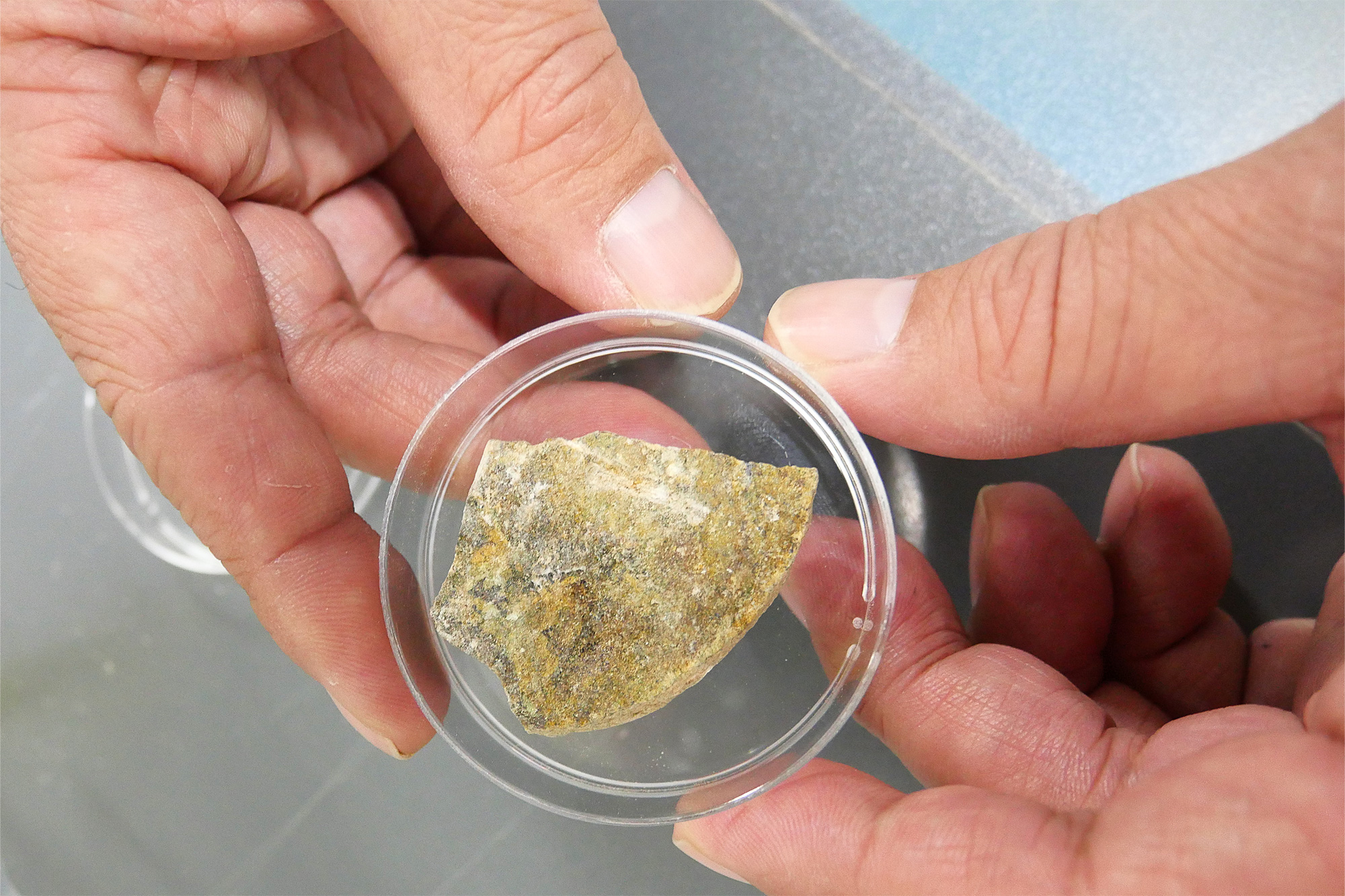
A prepared rock sample from a deep-sea drilling expedition. The geoscientist Yohey Suzuki and his colleagues developed a novel way to identify and count the cells living inside these rocks.
Caitlin Devor, University of Tokyo, CC BY 4.0
Most of the handful of studies that have examined life in basalts have focused on rocks near hydrothermal vents or newly made seafloor — relatively young rocks that are only up to 8 million years old. That’s because it’s in younger rocks that seawater can most easily circulate and replenish the microbes’ food supply. Those rocks are also more chemically reactive, and certain “rock-eating” microbes can use those reactions as an energy source, too.
But as basalt cools and moves away from where it was formed, further along the ocean floor toward subduction zones, its many cracks and pores fill up with precipitated minerals, preventing this more active fluid flow and leading to a more isolated system. It was unclear whether life could survive under such conditions — until now.
Cells Inside Ancient Basalts
Last month, a team of scientists in Japan reported life in basalts collected by a 2010 drilling expedition that had reached 120 meters into the crust beneath the ocean, to rocks that were between 33 million and 104 million years old. The age of the rocks alone was exciting, according to Lloyd, who did not participate in the study. “When it formed, dinosaurs were walking the Earth.”
But even more tantalizing were the densities at which the microbes were growing in the rocks. The researchers, using a new technique to precisely enumerate the cells in their samples, found that the microbes were concentrated in a particular subset of the basalt’s mineral-filled fissures. There, they formed something like a biofilm, reaching counts of 10 billion cells per cubic centimeter. “[We] didn’t think that there [would be] so many cells in old, cold, hard rocks,” said Yohey Suzuki, a geoscientist at the University of Tokyo and the lead author of the study.
The researchers were also able to map which types of minerals the cells did and did not associate with. They posit that the bacteria survived by living off of organic matter trapped in those minerals.
“That opens up much, much more of the seafloor that we now know should host microbial life,” said Jason Sylvan, a biogeochemist at Texas A&M University who was not involved with the research.
In fact, it suggests that the recipe for life might be less stringent than previously expected. Perhaps all that’s needed to sustain it is a combination of rock and fluid flow.
That’s not an entirely new idea. In places like South Africa and Canada, work in terrestrial deep mines — which descend into rocks that are billions of years older than the oldest seafloor basalts — has hinted at this for the past decade. Sherwood Lollar, along with Princeton University’s Tullis Onstott and other colleagues, have ventured into those mines to study what they call “the hidden hydro-geosphere,” systems of water isolated deep underground on long geological time scales. In some cases, they’ve found water that hasn’t been exposed to surface environmental factors in millions or even billions of years.
And in that billion-year-old water, the researchers have found life.
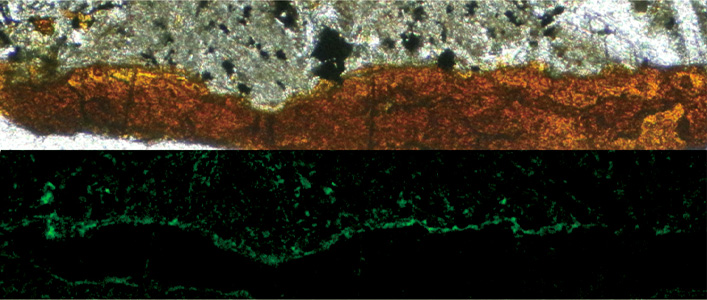
Two views of a cross-section through old sub-surface basalt. At top, in light microscopy, the basalt appears gray and the clay minerals filling a crevice are orange. At bottom, under fluorescence, stained bacteria on the surface of the minerals glow green.
Suzuki et al. 2020, DOI: 10.1038/s42003-020-0860-1, CC BY 4.0
They’ve also found evidence that those microbes persist by getting energy from an abiotic process called radiolysis, during which radiation released by the rocks reacts with water in the system to release hydrogen, which the cells can then use in various forms as fuel. That’s posed an intriguing question for scientists: Could radiolysis be an alternative process driving much of subsurface life?
Given that radiolysis occurs everywhere, “it could also be supporting the ocean deep life,” Orsi said. “No one knows.”
It’s much more difficult to obtain evidence of that in marine environments, where there’s more fluid flow and less obvious isolation. But D’Hondt, who participated in the study of the old sub-seafloor basalts, posits that the bacteria recently uncovered there might rely on radiolysis, too. “It’s hard to imagine enough organic matter bleeding in there to support these cell densities,” he said. Perhaps radiolysis is part of the picture as well. The relative isolation of the habitat, thanks to the mineral filling, makes it an intriguing subject for future study.
At the very least, “we basically learned from the [terrestrial] work that life can fit into almost any crevice that has water,” said Jennifer Biddle, a marine scientist at the University of Delaware. Now, the kind of work done by Suzuki, D’Hondt and their team is showing “that the marine environment is following the same rules as the terrestrial environment: As long as you have space and water, you’ve got a chance of something going,” she said. Maybe that applies to radiolysis, too — maybe it’s to subsurface life what photosynthesis is to surface life.
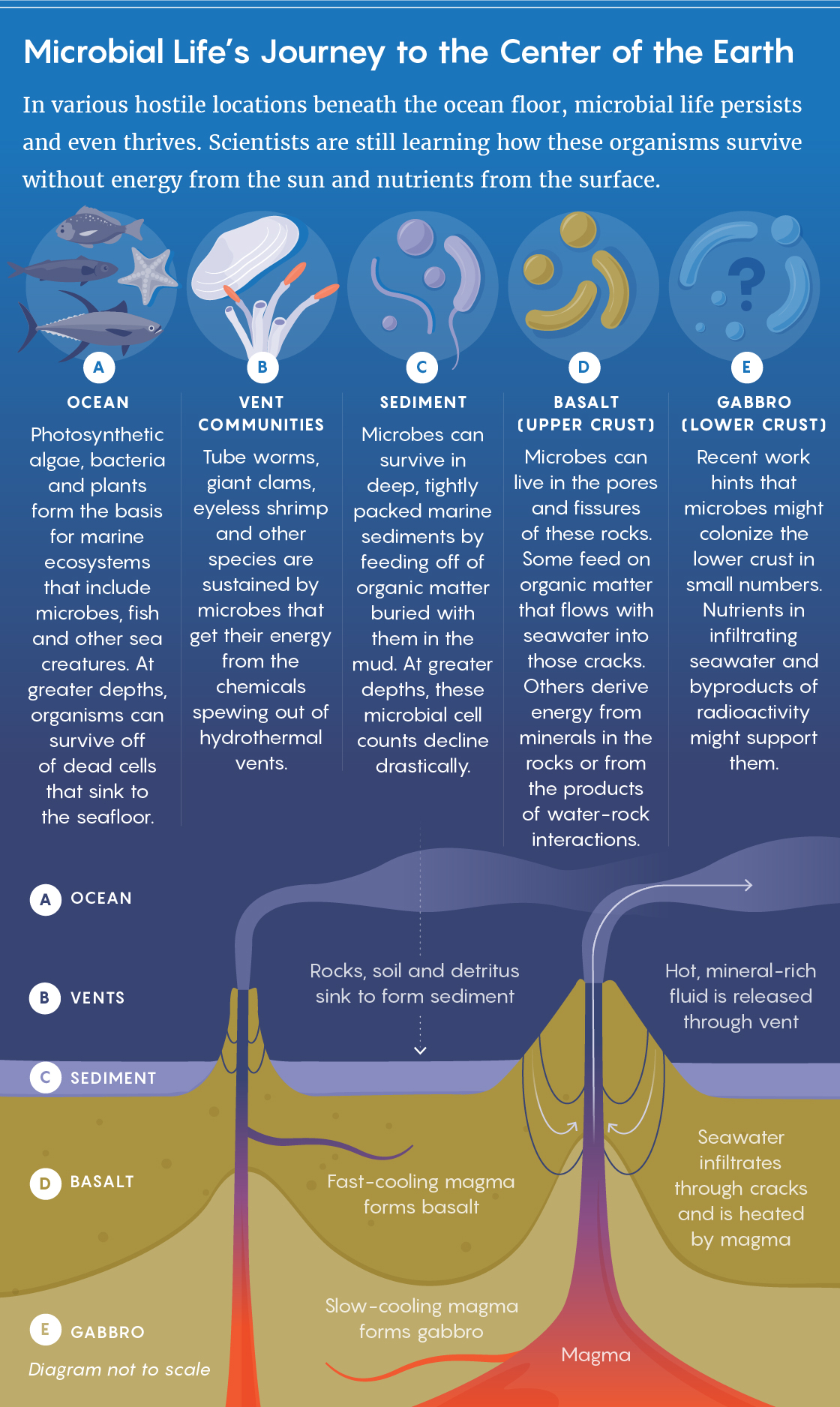
Lucy Reading-Ikkanda/Quanta Magazine
Regardless, it teaches scientists an important lesson: that to understand any deep-sea life, they can’t just look at the rocks. They also have to study the water — how it flows, or doesn’t. Several groups are now doing this in basalt systems throughout the world.
And it offers a new way to visualize potential limits to life. Traditionally, researchers hypothesize that life is most frequently limited by temperature. Above around 120 degrees Celsius, even the hardiest microbial cells break apart and die. But another major factor seems to be this all-important fluid flow. As long as the temperature stays cool enough, life “may go as deep as seawater can penetrate,” D’Hondt said.
Perhaps most important, such studies of fluid flow offer a new lens through which to scrutinize life’s origins and evolution.
Inside Earth and Beyond It
Since the discovery of hydrothermal vents, Sherwood Lollar said, “we’ve seen a shift from the idea of Darwin’s ‘warm little pond’” as far as the origin of life is concerned. Now, we may need to consider not a warm little pond or a hydrothermal vent, but what Onstott has called “a warm little fracture” — particularly when one takes into account the bombardments and other hostile environmental factors that would have characterized the surface of early Earth. “You have volcanic rock and water, and you can get life going,” said Fisk, who recently modeled this possibility.
That is, it’s possible that life might have gotten its start on the surface of the Earth, where it found creative ways to survive and spread, including to deeper environments. But it’s also possible that life began underground, at some fortuitous juncture between rock and water — eventually also making its way to the surface and figuring out how to harness the sun’s energy. (On that note, photosynthesis-dependent surface life and radiolysis-dependent subsurface life have so far been found to have an ancient, shared ancestry — but some researchers are intrigued by the possibility that life could have evolved more than once on Earth, in a “second genesis.”)
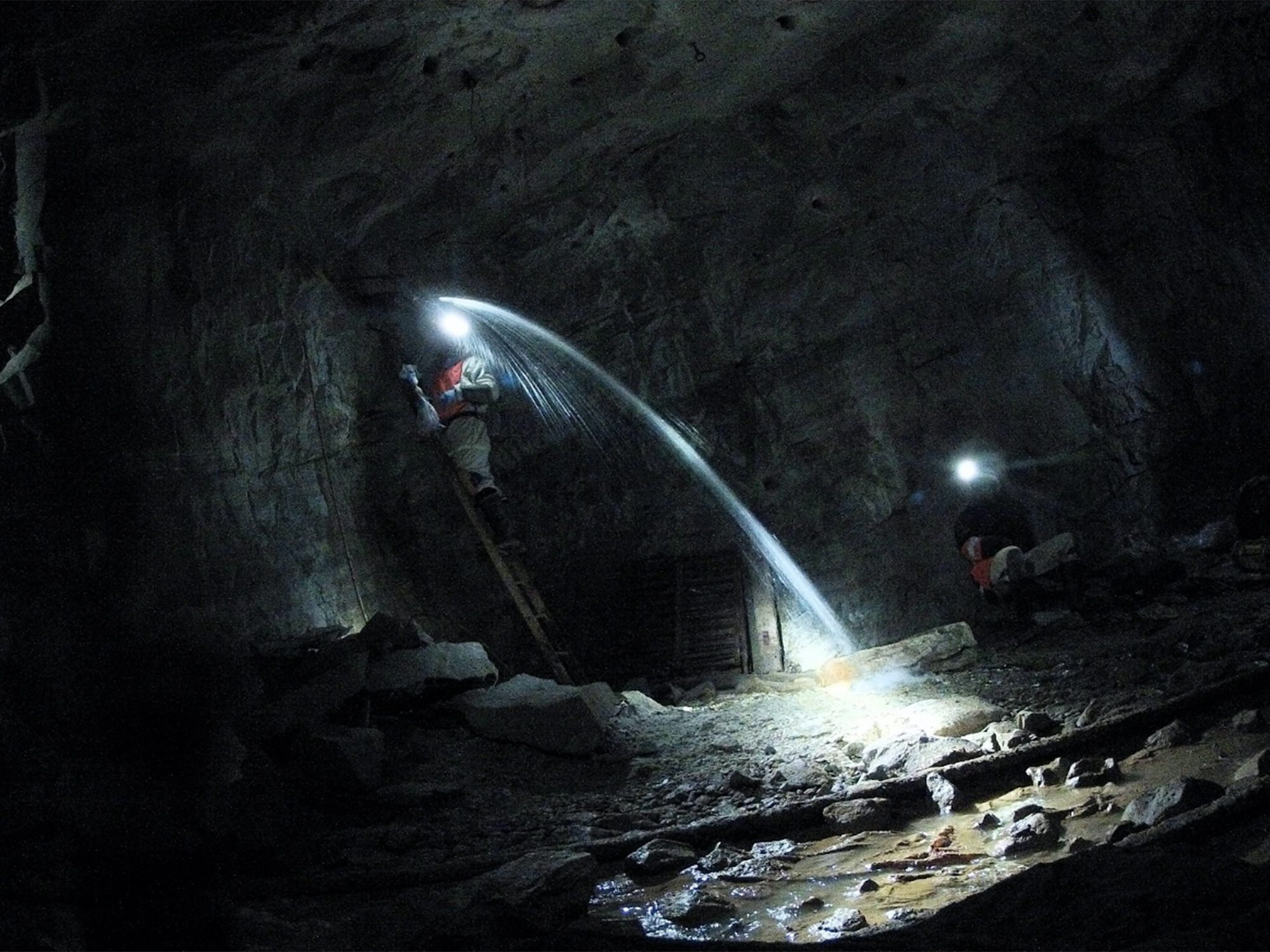
Water pouring into this South African mine shaft attests to the abundant liquid circulating through fissures and fractures far below the Earth’s surface. Scientists can analyze how long that water has been isolated from the surface world.
Gaetan Borgonie
That, in turn, has significant implications for the search for life on Mars, Saturn’s moon Enceladus and exoplanets beyond our solar system. Given the prevalence of water and volcanic rock throughout the universe, “life could have started anywhere,” Fisk said.
D’Hondt agreed. “From a literally universal perspective, it opens up the potential for sustaining life on all kinds of planets,” he said. “There could be life on other worlds that’s independent of photosynthesis,” thriving beneath the surface, out of sight.
Even more intriguing, perhaps life can evolve and adapt down there, too — perhaps very differently from how it has on the surface. Given how slowly the cells beneath the ocean floor grow, could they also be adapting on much more gradual time scales?
A couple of preliminary studies, conducted in younger sediments, have not found evidence for such evolution — but those only dealt with one type of deep subsurface environment, and even then, they went back only around 10,000 years. That might not be enough time for a slower kind of natural selection to have played a role. “What if you go back a million years or 10 million years?” Orsi asked.
Older sediments — as well as other sub-seafloor environments, such as the basalts examined by Suzuki and D’Hondt — might hold fresh insights. “When you expand the possibilities to greater and greater time scales” and contexts, Lloyd said, “then you have a wider array of possible drivers for evolution.”
Even now, scientists are continuing to push further, deeper. A paper published in Nature in March, spearheaded by Edgcomb, detailed the results from one of the most ambitious such pushes to date. They drilled nearly 800 meters below the seafloor at a location where the lower ocean crust bulges up closer to the surface. There, they sampled gabbro rocks, which are formed when magma cools more slowly: They’re typically found beneath basalt and considered a sort of window into the mantle, as well as into what an earlier Earth’s rock environment might have looked like. And in those rocks, the scientists reported trace numbers of cells — which once again seemed to be surviving off nutrients they gleaned from the flow of seawater. Although other researchers, including Orsi, have raised concerns about the possibility that those samples were contaminated, they also expect future analyses to uncover life down there.
No matter what, Edgcomb said, echoing the famous line from Jurassic Park, “life finds a way.”
This article was reprinted on TheAtlantic.com.



